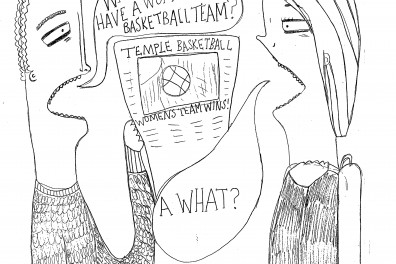

It’s a Thursday evening, and McGonigle Hall is desolate. Half of the Cherry and White band is in the stands, and we are nervous to talk too loudly for fear our voices will echo across the gymnasium and distract the women’s basketball team. When it’s time to cheer, we overcompensate for the near-silence that consumes the rest of the spectators.
Unfortunately, the scenario described above is the norm for the majority of the women’s basketball games I have attended as a member of the band. In contrast, the entire band attends every men’s game, and most of the time, we feel that we hardly sound loud enough. I would be remiss if I didn’t add that men’s home games are held at the larger Liacouras Center, due to the fact that Temple athletics must pay the center to use its facilities.
Statistics from the 2012-13 basketball season prove that women’s basketball is significantly under-attended. According to OwlSports.com, each of the 17 Temple men’s basketball home games had an average of 5,917 attendees. The 13 women’s basketball home games averaged just 941 spectators per game.
“It’s always been that there are less people at women’s games,” said Nicole Lusskin, a junior music education major and a member of the pep band. “There are events going on at [men’s games], there are themes. They don’t really do that for women’s games, so it attracts less people.”
One of the themes Lusskin referred to was the annual “Whiteout.” Fans are encouraged to wear all white, and Temple even provides free T-shirts.
Would offering merchandise to fans with an event like the “Whiteout” bring more fans to McGonigle Hall? The University of Southern California’s women’s basketball team also struggled with home game attendance in its 2012-13 season, with an average of 850 fans at each of the 17 home games, according to the team’s website.
Gabrielle Nowack, a junior narrative studies major at USC, said she has never attended a women’s basketball game. “To be honest, I just hadn’t heard that much about [women’s basketball],” Nowack said.
USC, unlike Temple, tries harder to incentive students to attend games of less popular sports by giving away free gear.
“They’ll raffle off Trojan merchandise – the first 200 people to show up will get a free T-shirt,” Nowack said, though that doesn’t encourage her to go to games. “I don’t need more paraphernalia, so I don’t usually go.”
USC’s lack of success with giveaways suggests that special events work to bring more fans to games held by teams with an already established fan base, such as Temple men’s basketball, but do little to interest students in trying something new.
Nowack said she prefers to go to football games partly because more of her friends attend them, but also for a more obvious reason: “We’re good.”
The University of Connecticut’s women’s basketball program thrives for that very reason. As arguably one of the best teams in the country, UConn racked up an average of 8,977 spectators at each of the 20 women’s home games in the 2012-13 season, according to UConnHuskies.com.
Perhaps emphasizing a team’s achievements increases attendance more successfully than promotional offers do. But with a team that hasn’t qualified for the NCAA tournament in the past two years, what can Temple do to get its students to care more about women’s basketball?
Junior UConn student Jay Garrish said he believes it takes more than raw talent to get the study body interested in games.
“The team markets itself extremely well,” Garrish, a history and secondary education major, said. “They’re public figures here and are totally personable. UConn’s basketball program produces players that are modest about their position on campus and proud of their school, which personally makes me feel like a part of the team.”
The idea of players having a presence on campus seems to be lacking in Temple sports across the board. This is especially true for women’s basketball. Having a personable team is a strategy Temple athletics appears not to have touched on yet. However, if it works closely with team members and focuses its advertising campaigns more toward the charisma of individuals on the team instead of vague ideas like “#ItBegins,” women’s basketball may start to see attendance rates creep up.
As far as the women’s team’s success goes, cultivating a proud and active fan base could help. If Temple is able to form a sixth man – or woman, in this case—with its fan base, the women will certainly take advantage of the adamant support they are not accustomed to.
This is quite the catch-22, as fans only want to watch a good team and teams aren’t going to play hard without a raucous fan base behind them.
“To have an opportunity to watch [UConn women’s basketball] regularly is unbelievable, and something I think many people at schools where [Division 1] athletics reign take for granted,” Garrish said.
Boosting the morale surrounding our women’s basketball team could help Temple students reach the same realization.
If Temple’s athletic department works as hard to market the women’s team as it does for the men or even as UConn’s women’s basketball program does, the pep band might start having to attend a few tournament games. And I, for one, would not complain.
Grace Holleran can be reached at grace.elizabeth.holleran@temple.edu or on Twitter @coupsdegrace.


Be the first to comment